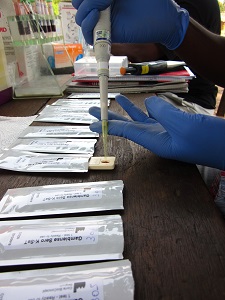A guide to spotting forgotten diseases

Related topics
Health Innovation International cooperation Health, Demographic Change and Wellbeing Belgium France United Kingdom Switzerland India Indonesia Mali Nepal Congo, The Democratic Republic Of The Sudan United States of Americadate: 05/08/2015
Project: Syndromic approach to Neglected Infectio...
acronym: NIDIAG
See also: CORDIS
Fatal or disfiguring diseases spread by pests – such as sleeping sickness or leishmaniasis – are often still widespread in very poor regions. Under-researched and under-treated, these diseases persist because of limited regional health services and low interest from drug companies.
Cheap, effective cures are becoming more common. But with the early symptoms of the diseases often vague, strong side-effects from treatments and restricted budgets, doctors need to be sure they target drugs to those who need them.
The EU-funded NIDIAG project is drafting guidelines that could take the guesswork out of diagnosing these neglected infectious diseases (NIDs). Its approach combines evidence from symptoms with on-the spot, pin-prick blood tests, replacing expensive, invasive testing in distant hospitals.
Tine Verdonck manages the contribution of project coordinator Institute of Tropical Medicine Antwerp. She says: “Our method helps doctors reach a more accurate diagnosis more quickly. The right treatments exist – they just don’t get to the right people.”
To illustrate the need for accurate diagnosis, Verdonck describes a Congolese study where 350 people had symptoms suggesting sleeping sickness. In fact, tests showed that only 10 of them had the disease. They needed urgent treatment, but so did almost 15% of the other patients – for other serious diseases.
According to the World Health Organisation, NIDs cost developing countries billions of dollars a year in unnecessary tests, misdiagnosis and labour lost from delayed treatment. The project provides specific guidance for NID policies in each participating country.
Diagnostic guidelines are close to the test phase for patients with nervous system symptoms – such as pain, numbness or muscle weakness – while guidelines for fever and digestive symptoms are in the pipeline. Project partner Coris BioConcept, a Belgian SME, has also developed a rapid diagnostic test that completes the diagnosis for sleeping sickness, says Verdonck.
A patient-centred approach
Verdonck explains the reasoning behind the project’s approach: “New patients don’t claim to have a specific disease, they present with complaints and symptoms. These might be linked to an NID or something else, so our guidelines work from the symptoms up to identify their cause.”
Using on-the-ground studies and medical literature, the team looked for the most common causes of nervous symptoms, fever and digestive problems. Armed with this analysis, they drew up guidelines to eliminating causes for these symptoms until a correct diagnosis is near.
If doctors then suspect an infectious disease, they can perform a rapid diagnostic test (RDT) in their clinic to confirm or rule out many of these diseases. Taking just half an hour, and only one drop of blood, an RDT is a simple, cost-effective test for antibodies or antigens linked to an infection.
Other investigations can supplement the RDT-based approach while tests are being developed for more NIDs, says Verdonck. She predicts that work to develop the project’s sleeping sickness RDT, along with patient samples from the project, could help develop other new tests.
Local trials will help the team refine the guidelines and evaluate the savings and sustainability of their approach, says Verdonck. Currently available on paper, the guidelines can be transferred to an electronic format such as a phone app if demand and local infrastructure make this viable.
“The team learned how to combine information from social sciences, clinical science, economics and basic biomedical science to create something useful and respond to a concrete need in the field,” says Verdonck.
She concludes: “It is unacceptable that so many people die from infectious diseases for which treatments exist. But it is rewarding to work on something that is really needed.”
Trypanosoma brucei parasites (sleeping sickness parasites)
© Quentin Gilleman; Philippe Büscher
Check also our publication Investing in European success - EU-Africa cooperation in science, technology and innovation
